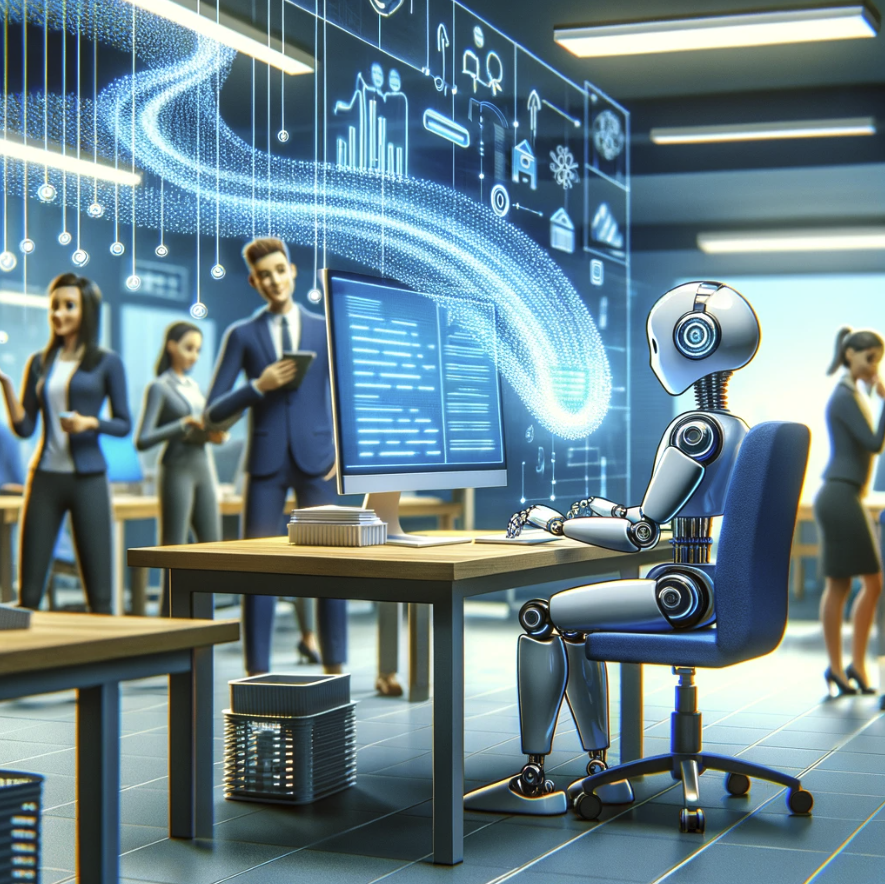In recent years, the “Bring Your Own Artificial Intelligence” (BYOAI) trend has carved out its niche in the corporate world.
This movement encourages employees to integrate their personal AI tools into their work routines, aiming to boost productivity and foster innovation.
Table of Contents
Understanding BYOAI
At its core, BYOAI is about leveraging personal AI technologies to streamline tasks, make data-driven decisions, and unleash creativity in the workplace. It’s akin to having an extra set of hands or a second brain that’s hyper-efficient at crunching numbers, analyzing trends, and even drafting content.
The Why and How
Companies are embracing BYOAI for several reasons. Primarily, it accelerates workflow and sharpens competitive edges. Imagine slicing through data analysis like a hot knife through butter or drafting reports at the speed of thought. That’s the promise of BYOAI.
Implementation Strategies
Implementing BYOAI requires more than just a nod of approval. It’s about creating an ecosystem where AI tools and human intelligence complement each other.
Setting Ground Rules
Firstly, establishing clear guidelines is crucial. It ensures that while employees use AI to supercharge their work, they also maintain data privacy and adhere to ethical standards.
Training and Adaptation
Secondly, training is paramount. Not everyone may be on the same page about using AI tools effectively. Offering workshops or tutorials can bridge this gap, turning novices into proficient users.
Monitoring and Feedback
Lastly, feedback loops help. Monitoring how BYOAI impacts productivity and employee satisfaction can guide further adjustments and improvements.
The Impact of BYOAI
The BYOAI trend is more than just a fad; it’s a paradigm shift in how we approach work. From automating mundane tasks to generating insightful analytics, AI tools are changing the game.
Productivity Skyrockets
With AI handling repetitive tasks, employees can focus on complex problems that require human empathy and creativity. It’s not just about working harder but smarter.
Collaboration and Creativity
BYOAI also paves the way for unprecedented levels of collaboration and creativity. By offloading data analysis to AI, teams can spend more time brainstorming and innovating.
Challenges and Considerations
However, BYOAI isn’t without its challenges. Concerns about data security, privacy, and the potential for AI to make errors that humans overlook are valid. Addressing these requires a balanced approach, weighing the benefits of AI integration against its risks.
How companies monitor and evaluate the effectiveness of BYOAI
Companies monitor and evaluate the effectiveness of BYOAI using a combination of methods:
- Productivity Measures: Tracking key performance indicators (KPIs) to determine if BYOAI tools are positively impacting task completion speed, output quality, or cost reductions.
- Qualitative Feedback: Gathering employee and manager feedback through surveys, interviews, or focus groups to assess the tool’s usefulness, ease of integration, and overall impact on job satisfaction.
- Security Audits: Regular security scans identify potential vulnerabilities introduced by BYOAI tools, helping mitigate data breaches or unauthorized access to company systems.
- Compliance: Ensuring third-party AI tools adhere to industry regulations and company policies around data privacy, ethical use, and bias mitigation.
- Centralized Monitoring (if applicable): Some companies may implement a platform for employees to register BYOAI tools, allowing IT to monitor usage, identify potential conflicts, and track performance.
BYOAI and job displacement, skill redundancy
BYOAI, like most forms of automation, carries the potential for both job displacement and changes in the required skillsets. Here’s how:
- Job Displacement: Primarily a concern for jobs involving repetitive, highly predictable tasks easily replicated by AI algorithms. Data entry, some forms of customer service, and basic analysis may be vulnerable.
- Skill Redundancy: Certain skills become less valuable as AI takes over previously manual tasks. For example, if employees build a tool to automate report generation, their skills in compiling and formatting reports might become less vital.
- New Opportunities: BYOAI simultaneously creates demand for new and evolving AI-related skills such as model development, tool customization, data preparation, and ethical AI oversight.
Mitigating the Negative Impacts
Companies can proactively address the potential downsides of BYOAI through:
- Upskilling and Reskilling Programs: Investing in training programs to help existing employees develop the skills needed in an AI-driven workplace.
- Collaboration between Humans and AI: Focusing on BYOAI models that complement and improve human work, rather than entirely replacing it.
- Transparency: Clearly communicating the role of AI in the workplace and its potential impact on both specific roles and the overall workforce.
Looking Ahead
The BYOAI trend is reshaping workplaces, making them more efficient, innovative, and adaptable. As we navigate this new landscape, the focus should be on harnessing AI’s potential while safeguarding ethical standards and data privacy.
In essence, BYOAI is not just about bringing your own AI; it’s about bringing your best self to work, empowered by technology. As we tread this path, the fusion of human and artificial intelligence holds the promise of unlocking new horizons in the workplace.
Q&A – BYOAI Workplace Trend (Bring Your Own AI)
What is the BYOAI workplace trend?
The BYOAI (Bring Your Own Artificial Intelligence) workplace trend involves employees using their personal AI tools and applications at work to enhance productivity, efficiency, and innovation. This trend reflects a shift towards individual empowerment and customization in the workplace, where workers leverage AI to automate routine tasks, analyze data, and support decision-making processes.
How does BYOAI benefit employees and companies?
BYOAI benefits employees by allowing them to work more efficiently and creatively. It automates mundane tasks, freeing up time for complex problem-solving and innovation. For companies, BYOAI can lead to increased productivity, enhanced innovation, and a competitive edge in their industry. It also promotes a culture of technological advancement and continuous learning.
What types of AI tools are commonly used in a BYOAI environment?
In a BYOAI environment, common AI tools include natural language processing (NLP) applications for communication and writing assistance, machine learning platforms for data analysis and prediction, chatbots for customer service and support, and automation software for scheduling and task management. These tools are designed to streamline operations, enhance decision-making, and improve overall efficiency.
What are the risks or challenges associated with BYOAI?
The risks or challenges associated with BYOAI include data security and privacy concerns, the potential for inconsistent use of AI tools leading to discrepancies in work quality, and the need for adequate training and support. Additionally, there’s the risk of over-reliance on AI, which may overlook the nuanced understanding and creativity that human judgment provides.
How can companies implement BYOAI effectively?
To implement BYOAI effectively, companies should establish clear policies and guidelines that outline the acceptable use of AI tools, focusing on security, privacy, and ethical considerations. Providing training and resources to ensure employees are proficient in using AI tools is also crucial. Furthermore, fostering a culture of openness to technological innovation can encourage productive and innovative use of AI.
Are there any privacy or security concerns with BYOAI?
Yes, privacy and security concerns are significant with BYOAI. These include the risk of exposing sensitive company data through third-party AI tools, potential breaches of customer privacy, and the challenge of ensuring all AI tools comply with regulatory standards. Companies must address these concerns by implementing strict security protocols and vetting AI tools for compliance and data protection capabilities.
How does BYOAI impact team collaboration and creativity?
BYOAI can greatly enhance team collaboration and creativity by automating routine tasks and data analysis, allowing team members to focus on creative problem-solving and innovation. AI tools can also facilitate better communication and idea sharing among team members, even in remote or distributed work environments. However, it’s essential to balance AI use with opportunities for human interaction and brainstorming to maintain a dynamic and creative team culture.
What training or support is necessary for employees in a BYOAI workplace?
In a BYOAI workplace, employees need training on how to effectively use AI tools, including understanding their capabilities, limitations, and best practices for security and privacy. Support might also include access to technical assistance for troubleshooting AI tools, continuous learning opportunities to stay updated on new AI technologies, and guidance on integrating AI tools into daily workflows.
How do companies monitor and evaluate the effectiveness of BYOAI?
Companies can monitor and evaluate the effectiveness of BYOAI by setting clear objectives for AI tool usage and measuring outcomes against these goals. This might involve tracking productivity metrics, quality of work, and employee satisfaction. Regular feedback from employees on their experiences with AI tools can also provide insights into areas for improvement and the overall impact of BYOAI on the workplace.
Can BYOAI lead to job displacement or skill redundancy?
While BYOAI has the potential to automate certain tasks, leading to changes in job roles and skill requirements, it doesn’t necessarily lead to job displacement or skill redundancy. Instead, it often shifts the focus towards higher-level tasks that require human insight and creativity. Employees may need to adapt and acquire new skills to work effectively alongside AI, suggesting a transformation in job roles rather than outright displacement.


